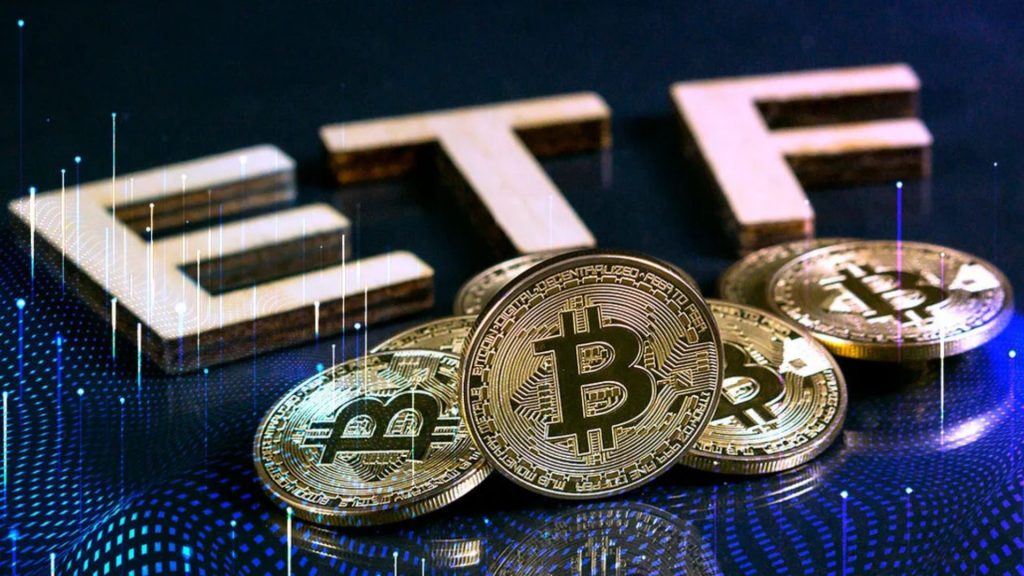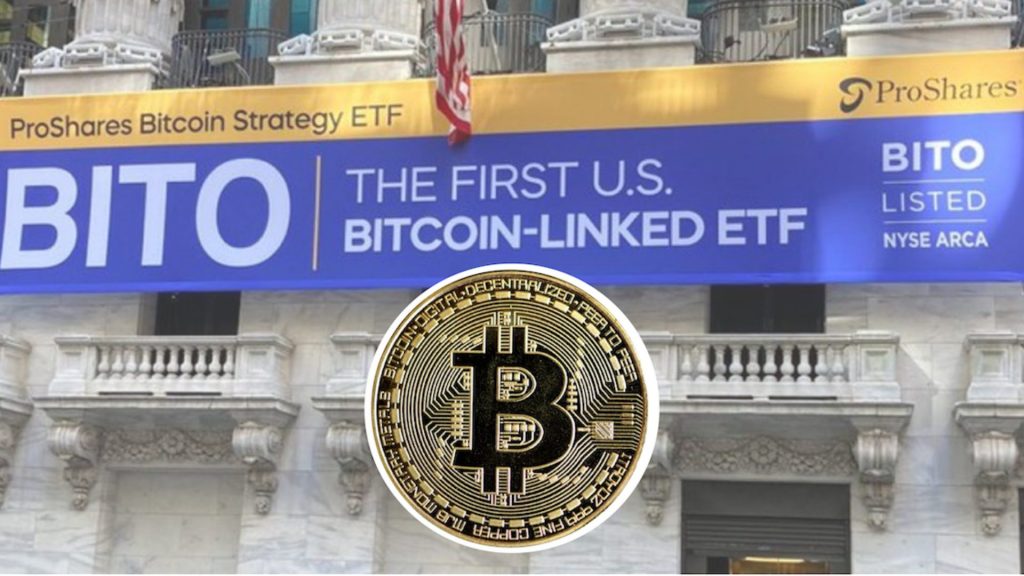This content represents the writer’s opinions and research and is not intended to be taken as financial advice. The information presented is general in nature and may not meet the specific needs of any individual or entity. It is not intended to be relied upon as a professional or financial decision-making tool.
Bitcoin lost half its value in 2022, declining to below $20,000 by the middle of the year. It was tough for investors, as they expected the cryptocurrency to shoot for the $100,000 mark. Still, those who placed short bets on the token went away with profits as the price continued to fall.
What if we had a strategy that allowed those skeptical of cryptocurrency trading to benefit from Bitcoin’s rise and fall? It will enable ordinary people to trade on the asset without owning it—a strategy that eliminates many entry barriers to trading. Furthermore, you can sell on regular stock exchange platforms, like standard stocks.
ProShares took the initiative by launching bitcoin-linked exchange-traded funds (ETF), BITO, and BITI. These ETFs simplify the process and provide new options for people who traditionally trade stocks. With that in mind, let’s examine these funds and how you can purchase and store them.
Table of Contents
What is BITI?

It is crucial to understand what an exchange-traded fund is before understanding BITI. Pro traders will be able to find their way around. Even so, new investors can navigate the waters easily with this guide.
An exchange-traded fund contains securities that track an index or instrument. It can be either passive or active, depending on how often the managers pick stocks based on their financial modeling or analysis. Also, their prices fluctuate as transactions ensue on trading platforms.
Specific ETFs contain bonds and stocks. The move into cryptocurrency is recent and is still new to most traders. Still, it offers a middle ground for those who prefer traditional stock exchanges to crypto trading sites.
A bitcoin ETF contains BTC or instruments that relate to its price. The assets have ties to bitcoin futures contracts traded on the Chicago Mercantile Exchange (CME). That is the organized exchange that allows the trading of futures.
Investors in the BITI or ProShares Short Bitcoin Strategy ETF trade bitcoin futures on the CME. The ETF takes short positions, meaning it gains if the bitcoin price drops.
BITI is a rolling index, with each roll occurring over five days monthly. It starts before the trade opens and closes before the last trading date. Trading occurs by tracking the nearest maturing bitcoin futures monthly.
Each five-day period gets a weight of 20% daily. Other significant numbers are the expense ratio, which is 0.95 percent, and the gross expense ratio, which is 0.97 percent.
Things to Note About BITI
This proposal might sound attractive. Moreover, you do not own any bitcoin assets. Futures trading involves risks.
Here are essential points to note about BITI
- It is not a direct investment in bitcoin.
- The fund tracks contracts speculating on bitcoin’s price (CME Bitcoin futures).
Despite that, there are upsides to trading BITI over bitcoin, including the following:
- It provides a way out for investors in markets where shorting is challenging.
- It helps investors overcome brokers that do not allow shorting.
- The strategy can help hedge against a collapse.
- You can buy it through a traditional brokerage.
Market timing is also essential when trading BITI. Before opening a trade, you must know the price. For example, investors would be more likely to invest in BITI when bitcoin began dropping from $60,000 than if it were at $20,000.
What is BITO?

We have covered the basics of BITI and its trading strategy. That leaves us with BITO, which is the opposite of the former.
BITO and BITI are the products of ProShares, the first and largest provider of bitcoin-linked ETFs in the US. Both provide exposure to bitcoin, but from opposing sides.
The Bitcoin Strategy ETF debuted on the New York Stock Exchange on October 19, 2021. In two days, it achieved an asset base of $1 billion, making it the fastest time for any ETF to hit the $1 billion mark. Bitcoin would later climb to its all-time high barely a month after that.
BITO is based on how much people think bitcoin will be worth when the contract ends. It tracks the futures contracts on the Chicago Mercantile Exchange. As a result, investors can bet on its future price.
You can use the exchange-traded fund to diversify your assets and seek capital appreciation. It can also be an alternative to traditional currency investments in the stock market.
Here is a broader view of what you get with BITO.
- It allows investors to use an ETF’s liquidity to gain exposure to bitcoin-linked returns.
- You don’t need a cryptocurrency exchange or wallet to buy and sell BITO.
- It remains the most actively traded ETF on a cryptocurrency.
Due to the extra costs of the futures contracts, this ETF could become more expensive than direct investments in bitcoin. These costs can affect the price, the total spot price, and the cost of holding the ETF until it matures.
That is in contrast to buying bitcoin on a cryptocurrency exchange, where you get all the assets and pay a lower fee. Bitcoin might perform better than BITO, but the latter is still a viable alternative.
How to Buy BITI and BITO: A Step-by-Step Guide?
These ETFs are available on most trading platforms with simple processes. You can also contact your brokerage or financial advisor to purchase them. What you cannot do is buy them on ProShares.
Knowing the available trading platforms is one thing, but buying BITO and BITI on them is another. Thankfully, they have a simplified process that will give no trouble, even to new users.
This step-by-step guide will show you how to buy BITO and BITI:
Create a new account with an online brokerage or trading platform
You will have a couple of options, as these ETFs are widely celebrated in the trading community.
You can shop for other trading platforms if they don’t suit your fancy. However, ensure that whichever you pick supports ETFs. Create a new user account or use an existing one if you have one.
Fund your account
You need funds to purchase these ETFs. Once logged in, find deposits and pay money into your account. You will find several payment options, depending on the brokerage. Pick one and deposit the amount you want to use for the trade.
Choose BITO or BITI
Go to the available ETFs and locate BITO or BITI. Some trading platforms have a search bar for users to find an instrument quickly. Click on what you want and proceed to purchase.
Complete the order
Complete your order, and the brokerage will process your purchase. The transaction should take a few seconds before you get a notification.
The list below shows the platforms or brokers that offer the option to trade BITI and BITO
How to Store BITI and BITO in a Wallet and Which Wallet You Should Use?
Unlike cryptocurrencies, you don’t need a separate wallet to store your BITO or BITI. Storage occurs directly in your brokerage account. Your investment will remain there until you sell them out using the trading function.
These include the following:
- Fees include maintenance charges, trading, administration, etc.
- The minimum deposit allowed by the brokerage.
- Assets available, including ETFs, indexes, and instruments.
- Presence of exclusive features like automatic tax-loss harvesting.
- The efficiency of customer support.
You can store your BITO or BITI ETF at the following brokerages: Charles Schwab, Robinhood, TD Ameritrade, Interactive Brokers, Fidelity, Vanguard, and E-Trade. Storage happens automatically once you purchase the assets.
You can also pick your brokerage from the following types:
They have no restrictions for buying and selling, but you will pay taxes. Every sale or accrued dividend is liable to taxation
They can be tax-deferred or tax-free. You can use them if you are of retirement age and more invested in saving.
A 529 plan is a tax-advantaged savings account designed to be used for the beneficiary’s education expenses.
A custodial account is generally created by a parent or grandparent for the benefit of a minor child or grandchild.
BITI and BITO Forecast 2023
BITO debuted in October 2021, while BITI came out in June 2022. The former was the most successful ETF launch at its debut, starting at about $40. It climbed to its all-time high of $43.28 a few days after its launch.
The trend for the BITO ETF has been downward since the turn of 2022. The ETF ended the year at $10.43 after losing over 70% of its launch value. It has slowly picked up the pace, climbing to $14.19 by January 20, 2022.
Bitcoin’s eventual rise might trigger reinvestments in BITO. The ProShares Bitcoin Strategy ETF has significant holdings in bitcoin futures. If Bitcoin continues the bullish trend, its price could reach half its all-time high at $23.94.
The BITO ETF might end 2023 trading at an average price of $20. Still, we must look at Bitcoin’s price trend to predict.
The BITI ETF works differently, as it profits when BTC falls. The fund debuted on June 9, 2022, before reaching its all-time high of $45.33 on November 9, 2022. We only witnessed significant drops at the turn of 2023 as BTC rebounded.
While the fund traded for $28.68 on January 20, 2023, we expect it to recover from its fall. Still, it will be herculean to pit it against a rising Bitcoin market.
Conclusion
ProShares’ Bitcoin Strategy and ProShares’ Bitcoin ETF are excellent ways to invest in BTC futures. They save investors the stress of owning BTC directly while providing an accessible trading medium. You can buy them on brokerages, the most popular being Charles Schwab, Robinhood, TD Ameritrade, Interactive Brokers, Fidelity, Vanguard, and E-Trade.
BITO and BITI depend on BTC futures contracts, but the latter profits when the BTC price falls. In 2022, it did pretty well compared to BITO, which was getting worse and worse. Now, BTC is making a comeback, and it will be intriguing to watch how they perform.
Frequently Asked Questions
Why should I invest in Bitcoin ETFs?
Investing in BTC ETFs is not the same as owning BTC directly. Instead, you invest in futures contracts linked to the asset, giving yourself more versatility. Some use the ProShares Short Bitcoin ETF to hedge against a market crash.
What is the difference between BITO and BITI?
BITI takes short positions, meaning it gains if the bitcoin price drops. BITO relies on the expected price of bitcoin, which terminates on the contract’s expiration date.
Both funds track BTC futures contracts on the CME. Several brokerages offer support, including TD Ameritrade, Fidelity, Vanguard, E-Trade, etc. Create an account with them, and you can purchase BITO and BITI.
WeInvests is a financial portal-based research agency. We do our utmost best to offer reliable and unbiased information about crypto, finance, trading and stocks. However, we do not offer financial advice and users should always carry out their own research.
Read More







